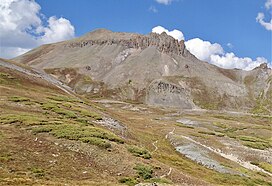
Electric Peak is a 13,292-foot-elevation (4,051-meter) mountain summit located in San Juan County, Colorado, United States. It is situated eight miles south of the community of Silverton, in the Weminuche Wilderness, on land managed by San Juan National Forest. It is part of the Needle Mountains which are a subset of the San Juan Mountains, which in turn is a subset of the Rocky Mountains. Precipitation runoff from the mountain drains into tributaries of the Animas River. The peak can be seen from U.S. Route 550 and the Durango and Silverton Narrow Gauge Railroad. Topographic relief is significant as the west aspect rises over 4,500 feet above the river and railway in approximately two miles. It is set five miles west of the Continental Divide, and one mile east of Mount Garfield. The mountain's name, which has been officially adopted by the United States Board on Geographic Names, was in use before 1906 when Henry Gannett published it in the Gazetteer of Colorado.
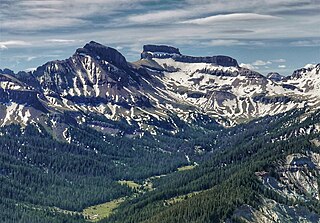
Coxcomb Peak is a 13,656-foot-elevation (4,162-meter) mountain summit located on the common boundary of Hinsdale County and Ouray County, in Colorado, United States. It is situated nine miles northeast of the community of Ouray, in the Uncompahgre Wilderness, on land managed by Uncompahgre National Forest. It is part of the San Juan Mountains which are a subset of the Rocky Mountains, and is situated west of the Continental Divide. Coxcomb ranks as the 171st-highest peak in Colorado, and topographic relief is significant as the south aspect rises 2,000 feet above Wetterhorn Basin in approximately one mile, and 4,400 feet above Cow Creek in three miles. Neighbors include Precipice Peak 2.7 miles to the north, Redcliff one-half mile north, Matterhorn Peak 2.3 miles to the east-southeast, and nearest higher neighbor Wetterhorn Peak 1.8 mile to the southeast. The mountain's descriptive name, which has been officially adopted by the United States Board on Geographic Names, was in use since at least 1906 when Henry Gannett published it in the Gazetteer of Colorado.

Abrams Mountain, also known as Mount Abram or Mount Abrams, is a 12,801-foot-elevation (3,902-meter) mountain summit located on the shared boundary of Ouray County with San Juan County in southwest Colorado, United States. It is situated four miles south of the town of Ouray, on land managed by Uncompahgre National Forest. It is part of the San Juan Mountains, which are a subset of the Rocky Mountains, and is west of the Continental Divide. Topographic relief is significant as the north aspect rises 3,800 feet above Uncompahgre Gorge in 1.5 mile. Historic mines are located on the slopes of Abrams Mountain. This iconic feature of the Ouray landscape can be seen for many miles while driving Highway 550 south from Montrose toward Ouray, and it dominates the San Juan Skyway from Red Mountain Pass to Ironton Park.

Courthouse Mountain is a 12,152-foot-elevation (3,704-meter) mountain summit located on the shared boundary of Hinsdale County with Ouray County, in southwest Colorado, United States. It is situated 10.5 miles east of the community of Ridgway, and south of Owl Creek Pass, in the Uncompahgre Wilderness, on land managed by Uncompahgre National Forest. It is part of the San Juan Mountains which are a subset of the Rocky Mountains, and is situated west of the Continental Divide. Topographic relief is significant as the east aspect rises nearly 2,000 feet above West Fork Cimarron River in approximately one-half mile, and with its prominence can be seen from Highway 550 near Ridgway. The mountain's name, which has been officially adopted by the United States Board on Geographic Names, was in use before 1906 when Henry Gannett published it in the Gazetteer of Colorado.

Golden Horn is a 13,780-foot-elevation (4,200-meter) mountain summit located on the shared boundary of San Juan County with San Miguel County, in southwest Colorado, United States. It is situated nine miles west of the community of Silverton, on land managed by San Juan National Forest and Uncompahgre National Forest. Golden Horn is part of the San Juan Mountains which are a subset of the Rocky Mountains, and is west of the Continental Divide. It ranks as the 116th-highest peak in Colorado, and topographic relief is significant as the west aspect rises 3,800 feet in approximately 1.5 mile. The mountain's name, which has been officially adopted by the United States Board on Geographic Names, was in use in 1906 when Henry Gannett published it in A Gazetteer of Colorado.

Hurricane Peak is a 13,447-foot-elevation (4,099-meter) mountain summit located in San Juan County of southwest Colorado, United States. It is situated equidistant between the historic towns of Ouray and Silverton, and is approximately nine miles west of the Continental Divide. It is part of the San Juan Mountains which are a subset of the Rocky Mountains. Topographic relief is significant as the north aspect rises 1,200 feet above Lake Como in one-half mile. Neighbors include Abrams Mountain 3.4 miles to the north, Red Mountain 2.2 miles to the west, and Tuttle Mountain 1.4 mile to the north. The Mountain Queen Mine, which is located on the east slope of Hurricane Peak at the head of California Gulch, is one of the oldest workings in the area and was most active from 1878 to 1880. The mountain's name, which has been officially adopted by the United States Board on Geographic Names, was in use in 1906 when Henry Gannett published it in the Gazetteer of Colorado.

Lookout Peak is a 13,661-foot-elevation (4,164-meter) mountain summit located on the shared boundary of San Juan County with San Miguel County, in southwest Colorado, United States. It is situated three miles east of the community of Ophir, and one mile immediately north of Ophir Pass, on land managed by San Juan National Forest and Uncompahgre National Forest. Lookout Peak is part of the San Juan Mountains which are a subset of the Rocky Mountains, and is west of the Continental Divide. It ranks as the 166th-highest peak in Colorado, and topographic relief is significant as the west aspect rises 3,000 feet in approximately one mile. Neighbors include Silver Mountain three miles to the west-northwest, Wasatch Mountain two miles north-northwest, and Golden Horn five miles south-southwest. The mountain's name, which has been officially adopted by the United States Board on Geographic Names, was in use in 1899 when Henry Gannett published it in A Dictionary of Altitudes in the United States, and in 1906 when he published it in A Gazetteer of Colorado.
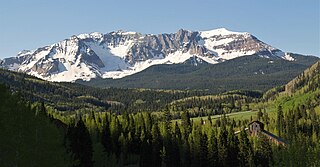
Sheep Mountain is a 13,188-foot-elevation (4,020-meter) mountain summit located on the shared boundary of Dolores County with San Miguel County, in southwest Colorado, United States. It is situated three miles south of Trout Lake and two miles southeast of Lizard Head Pass, on land managed by San Juan National Forest and Uncompahgre National Forest. Sheep Mountain is part of the San Juan Mountains which are a subset of the Rocky Mountains, and is west of the Continental Divide. Topographic relief is significant as the southwest aspect rises 3,200 feet above the Dolores River in approximately 2.5 miles. Neighbors include Golden Horn and Vermilion Peak to the east, and Lizard Head to the northwest. Sheep Mountain can be seen from the San Juan Skyway in the Lizard Head Pass and Trout Lake areas. The mountain's name, which has been officially adopted by the United States Board on Geographic Names, was in use in 1906 when Henry Gannett published it in A Gazetteer of Colorado.

Twin Sisters is a 13,432-foot-elevation (4,094-meter) mountain summit located in San Juan County, Colorado, United States. The lower west summit has an elevation of 13,374 feet and 0.43 mile separates the pair. Twin Sisters is part of the San Juan Mountains range which is a subset of the Rocky Mountains, and is west of the Continental Divide. It is situated 7.5 miles southwest of the community of Silverton, on land managed by San Juan National Forest. It is set 5.5 miles north of Engineer Mountain, and 2.2 miles east of Rolling Mountain, the nearest higher neighbor. Other neighbors include Snowdon Peak seven miles to the southeast, and Golden Horn, 3.5 miles to the northwest. Topographic relief is significant as the north aspect rises 3,000 feet above South Fork Mineral Creek in approximately 1.5 mile. The mountain's name, which has been officially adopted by the United States Board on Geographic Names, was in use in 1906 when Henry Gannett published it in A Gazetteer of Colorado.

Gravel Mountain is a 13,596-foot-elevation (4,144-meter) summit in Hinsdale County, Colorado, United States. It is located nine miles (14 km) southeast of the community of Ouray, on land administered by the Bureau of Land Management. It is situated eight miles (13 km) west of the Continental Divide in the San Juan Mountains which are a subrange of the Rocky Mountains. Precipitation runoff from the mountain drains into Henson Creek which is part of the Gunnison River watershed. Topographic relief is significant as the summit rises 2,800 feet above Henson Creek in approximately one mile (1.6 km). Access to the mountain is via the Alpine Loop Back Country Byway. The mountain's toponym has been officially adopted by the United States Board on Geographic Names, and has been recorded in publications since at least 1906.

Tuttle Mountain is a 13,208-foot-elevation (4,026-meter) summit in San Juan County, Colorado, United States.

Carson Peak is a 13,662-foot-elevation (4,164-meter) summit in Hinsdale County, Colorado, United States.

Greenhalgh Mountain is a 13,220-foot-elevation (4,030-meter) mountain summit in San Juan County, Colorado, United States.
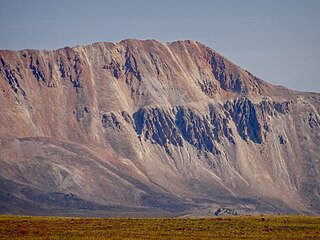
Sheep Mountain is a 13,292-foot-elevation (4,051-meter) mountain summit in San Juan County, Colorado, United States.
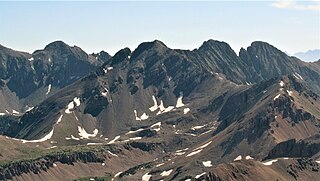
Spiller Peak is a 13,123-foot-elevation (4,000-meter) mountain summit on the common boundary shared by La Plata County and Montezuma County in Colorado.
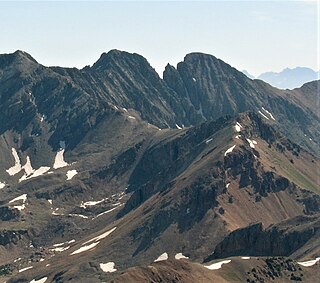
Babcock Peak is a 13,161-foot-elevation (4,011-meter) mountain summit in La Plata County, Colorado.

Grizzly Peak is a 13,738-foot-elevation (4,187-meter) mountain summit on the boundary shared by Dolores County and San Juan County, in Colorado, United States.

Kendall Peak is a 13,455-foot-elevation (4,101-meter) mountain summit in San Juan County, Colorado, United States.

Storm Peak is a 13,495-foot-elevation (4,113-meter) summit located in San Juan County, Colorado, United States.
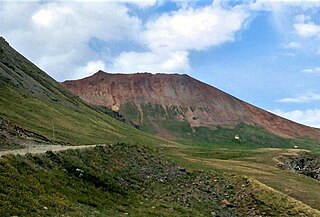
Wood Mountain is a 13,682-foot-elevation (4,170 meter) summit located on the boundary shared by Hinsdale County with San Juan County, in Colorado, United States.
